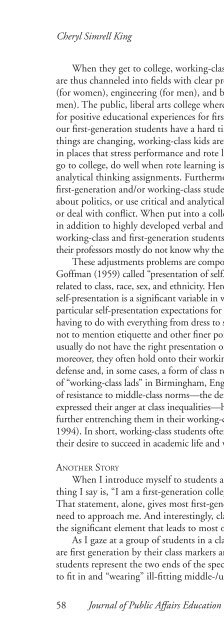WINTER 2012 - National Association of Schools of Public Affairs and ...
WINTER 2012 - National Association of Schools of Public Affairs and ...
WINTER 2012 - National Association of Schools of Public Affairs and ...
Create successful ePaper yourself
Turn your PDF publications into a flip-book with our unique Google optimized e-Paper software.
Amy E. Smith <strong>and</strong> Ignacio J. Martinez-Moyano<br />
Phase IV: Data Analysis<br />
Of those participating in the study, 5 <strong>of</strong> the 13 instructors were female.<br />
These instructors represented five <strong>of</strong> the six social science disciplines in our<br />
original target group. (No instructors from business programs participated in the<br />
study.) The colleges <strong>and</strong> universities with which the responding instructors were<br />
affiliated were predominantly public (9), the largest proportion <strong>of</strong> instructors<br />
being from public affairs programs (5). On average, this group <strong>of</strong> instructors<br />
had their PhDs for over 18 years (minimum, 3 years; maximum, 36 years) <strong>and</strong><br />
had taught statistics for over 16 years (minimum, 8 years; maximum, 31 years).<br />
During the idea elicitation stage, an average total <strong>of</strong> 41 ideas were generated<br />
for each challenge. The greater the number <strong>of</strong> ideas generated, the greater the<br />
potential for creativity in the Delphi process (Van de Ven & Delbecq, 1974).<br />
On average, for all four questions asked, participants placed more than two ideas<br />
in each cluster. The minimum number <strong>of</strong> ideas placed in a cluster was 1; the<br />
maximum was 10. These distributions were relatively right-skewed, <strong>and</strong> several<br />
clusters included only one idea.<br />
While only 7 <strong>of</strong> the original 13 instructors participated in all stages <strong>of</strong> the<br />
Delphi process, we provide summary statistics on all 13 <strong>of</strong> the instructors here<br />
because all 13 provided the initial list <strong>of</strong> ideas deemed essential for addressing the<br />
challenges. This elicitation <strong>of</strong> ideas formed the core <strong>of</strong> the remainder <strong>of</strong> the data<br />
collection stages.<br />
Identifying Agreement among Participants<br />
A major goal <strong>of</strong> this project was to identify the tools <strong>and</strong> techniques<br />
that instructors agreed are essential for addressing the challenges in teaching<br />
statistics to students enrolled in practitioner-oriented master’s degree programs.<br />
Participants’ rankings <strong>of</strong> clustered ideas were divided into three groups using<br />
the mean rating for the cluster <strong>and</strong> a simple majority rule. By using the simplemajority<br />
criterion, in conjunction with the mean rating for a cluster, we address<br />
potential issues arising from the sensitivity <strong>of</strong> the mean to outliers.<br />
The three groups created are the highest-importance group, the highimportance<br />
group, <strong>and</strong> the average-importance group. These groups capture how<br />
essential each cluster is for addressing the challenge in question. Thus, clusters in<br />
the highest-importance group are considered by the experienced instructors in<br />
our study as the most essential for addressing the challenge. Table 1 summarizes<br />
the method used to identify agreement among participants.<br />
FINDINGS<br />
According to the group <strong>of</strong> experienced instructors that participated in our<br />
research, when designing <strong>and</strong>/or selecting tools effective for learning, instructors<br />
should focus on using real-life, relevant examples; employing computer<br />
applications; <strong>and</strong> emphasizing the process, not the results. Additionally, to<br />
120 Journal <strong>of</strong> <strong>Public</strong> <strong>Affairs</strong> Education

















